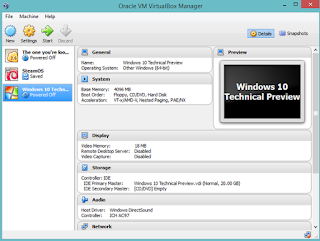Installing the Windows 10 Technical Preview
With all that done, it’s time to get the Tech Preview on your PC! But since it’s a very early pre-release build of the operating system, you probably don’t want to overwrite your PC’s operating system with Windows 10—especially since doing so renders Windows Media Player incapable of playing DVDs and removes Windows Media Center entirely from upgraded Windows 8.1 Pro installations. (Windows 10 won't support Windows Media Center.)
If you have a superfluous computer lying around, sure, feel free to install the preview on that. (My colleague Mark Hachman did, overwriting Windows 8.1—but only after creating a recovery drive.) But most people will want to install the Windows 10 Technical Preview either in a virtual machine, or dual-boot the OS from its own hard drive partition.
In a virtual machine
Installing it on a virtual machine is the easiest option. Grab VirtualBox, Oracle’s stellar no-cost VM tool, and you’ll be ready to rock. Download the Windows 10 Preview and configure it in VirtualBox using mostly the same steps outlined in PCWorld’s guide to test-driving Windows 8 in a virtual machine. (When you're initially setting up the Windows 10 VM, select "Windows 8.1" as the operating system type.)
If your attempt to install the Windows 10 VM isn't successful, try tweaking these settings. Once you’ve completed the initial Windows 10 set up, open the VM's Settings > System. In the Motherboard tab, ensure the box next to “Enable EFI (Special OSes only)” is checked, as well as the “Enable PAE/NX” box under the Processor tab.
It's worth noting that I encountered troubles installing the 64-bit version Windows 10 on VirtualBox—the installation hung right after the "Press any key to boot" screen, stuck forever on the Windows logo against a black background. Several others have been successful in getting it to work, however, and I was able to install the 32-bit version of Windows 10's Technical Preview in VirtualBox successfully. (I also successfully installed the 64-bit version to a hard drive partition, and another 64-bit instance overwriting Windows 8.1 on a laptop.)
Dual boot Windows 10 in a hard drive partition
Running operating systems in virtual machines also sacrifices some performance, especially if you don’t have extra CPU cores or much RAM to dedicate to the task. If you want to experience the Windows 10 Technical Preview natively, you can create a new partition on your hard drive and install the preview there. (It’s best if you’re able to do this on a secondary PC, just to be safe.)
PCWorld’s guide to installing Windows 8 on a new partition can walk you through the process—the same basic steps apply to the Windows 10 Technical Preview, and Windows 8 handles hard drive partitioning the same way Windows 7 did. Note that Windows 8 includes native tools for burning a bootable ISO to a DVD, however—simply right-click on the Windows 10 ISO file and select Burn disc image.
The Windows 7 USB/DVD tool can help you make a bootable USB drive with the Windows 10 ISO despite its name. One tip we have though for those installing from USB onto a desktop: use the native Intel USB ports. Some motherboards use discrete USB 3.0 controllers that Windows 10 may not recognize during the install causing it to bomb out. If it does fail mysteriously, consider trying a different USB 3.0 port with your best bet being USB 2.0 ports.
Subscribe by Email
Follow Updates Articles from This Blog via Email



No Comments